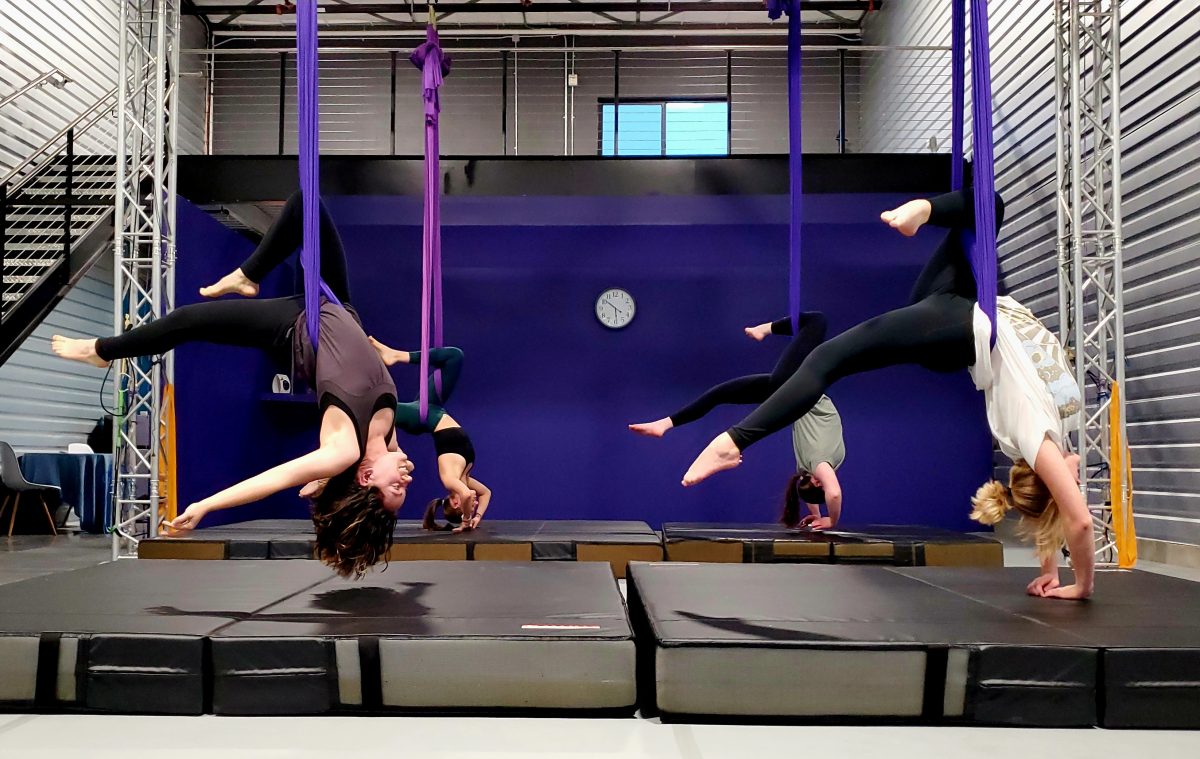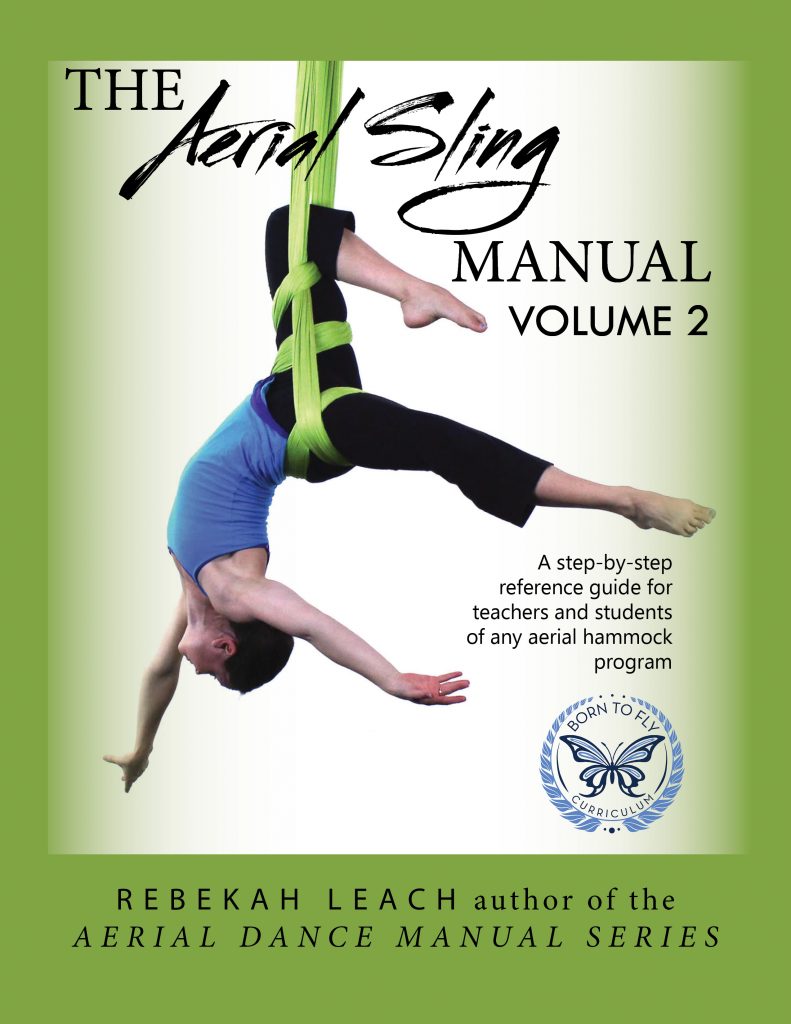Long time no write! A lot has changed in my life, and yet, at the same time, I’m back to the same ol’ same ol’ stuff of studio ownership and teaching aerial. The biggest difference between the “then” and “now” is that I have downsized dramatically. When COVID and other things changed everything, it was too much to go big, so I’ve gone small. I reopened my studio this year at a new location in Castle Rock, Colorado.
The space I found was small, and so I put up a truss system that was designed by the amazing Vertical Arts Dance company. (I highly recommend them for helping you set up a truss system and all the rigging that goes with it.) My truss comfortably fits 4 points, so I have up to 8 people in each class, and I teach all the classes! yikes!
I decided to scale back my program to teach just sling and silks. I used to teach pretty much anything and everything, but that was getting overwhelming, so now it’s just sling and silks. We do throw in the occasional trapeze or hoop into a show, but I don’t hold any major classes on these apparatuses anymore. And I still teach random things in private lessons like cloud swing or gasp–flying pole! (Ok, I don’t actually teach flying pole, but I have a student who comes in and I give artistic coaching as she moves on the pole. It’s really fun to work with!)
My aerial life is pretty simple, and I’m grateful because I have a lot to balance as my kids grow up. I teach sling on Tuesdays and fabric on Thursdays. On Fridays and Saturdays, I teach a blend through private lessons, open gyms, and foundational classes.
Generally, I teach about 20-25 classes/week, which I consider full-time in the land of aerial! (For comparison, a therapist generally sees clients for this same amount of time, and it is considered a full-time load. The rest of the week is spent in preparation for those hours: writing emails, managing payments/scheduling, etc.) If I were to demonstrate all the skills in all these classes, I would be at a major risk of injury which would jeopardize my entire career at the moment since I am the sole teacher at my little studio, so this article is actually to come on and tell you what is saving my career: NOT demoing anymore!
At a recent teacher training, I was talking about how little I demonstrate when I teach, and the participants couldn’t believe it! They couldn’t fathom how my teaching was still effective without showing all the skills, and I get it. It helps to see the skills done, and see the skills done right. In my demoing days, I enjoyed demonstrating all the skills slow and perfect. It kept ME in pristine aerial condition! I liked going through all the skills and when I walked through the skill myself, I was reminded of all the cues that I couldn’t remember off the top of my head. “Oh yeah, the silk does go around your back here…”
But I am now almost 20 years into this teaching gig (yes, I’m that kind of aerial dinosaur) and it is my sole profession. My body cannot handle the demo-all-the-time routine, but I am SO not ready to be done teaching. At first, I felt like I was going to be a worse teacher because I wasn’t going to demo, but I think I have gotten to be a BETTER teacher. I’d like to share what I’ve learned for all your hard-working teachers that find yourself wanting to teach full-time and know that your body can’t handle demoing that much day in and day out for years on end.
Lesson #1: When I say I don’t demonstrate, this is a general rule. I DO get up in the air sometimes, so it’s not like I am never in the air ever, but it is rare, and I always have the option to not demonstrate depending on how warmed up I feel that day. I have learned that if my body is not properly warmed up, I will have consequences that are not healthy for my body to endure, so I make sure to have “totally grounded” OR “totally in the air” days. The WORST thing I can do for my body is try to half-and-half it. I end up in the air not really warmed up, and, I don’t know about you, but this just wrecks me.
Lesson #2: Floorial is better than you give it credit for! Most of my teaching, especially for silks, is done from rolling around on the ground, walking through the skills. My students know that I’m not going to get up in the air and demonstrate so they listen really carefully. It’s true that sometimes it is very confusing as to what I am trying to convey. And yes, it may be easier to just show the skill, but we get through it pretty darn well. And when you do this as a sole method of teaching, let me testify– you get darn good at it, and your students get darn good at paying attention to your rolling-on-the-floor shenanigans.
Lesson #3: Use your students to demonstrate skills. I love asking for “guinea pigs” because my students love being guinea pigs! When I ask for a guinea pig, it’s a special place of honor because you get all the attention and all my corrective feedback. And you get to be the first to do the skill! I love asking “who wants to be my guinea pig?” and seeing tons of hands shoot up into the air. Even if the student doesn’t know the skill, that’s okay! In fact, that’s exactly why I need strong guinea pigs. They have to trust that I will take them into a new skill that they have never done before and be safe about it!
It’s especially easy to ask for someone to show a skill that is from a previous class or ask someone to show a variation of something. I ask for the whole spectrum of ideas. Having students show me what they remember is always a great starting place for a class, and it doubly serves to demonstrate to the student-who-wasn’t-there what they may have missed.
To create a strong pool of guinea pigs who are ready to tackle new skills, you must have established a consistent vocabulary. My students are so used to this option, that frequently when I start teaching a new skill, I simply select someone and say something like “start in catchers and we’ll go from there.” They know that I will simply talk them into the skill and off we go.
To get to the point where you have the right words to be able to do this is a skill in and of itself. Many teachers aren’t ready to rely on their words currently because they rely too heavily on demonstrating, and their students have relied on visual learning by watching their teacher. My students rely on vocabulary, and as such, their vocabulary is very strong, making our communication powerful. When they are in the air, I can cue corrections with greater precision than those students who need to “see it one more time and maybe get it next time.” My students have words for what steps they are missing, and everyone in the class can help point it out to them! Example: “You got the wrap around, but not the beat after the wrap around.”
I have seen amazing results when a student is demonstrating and I am giving the words because the words tell what to pay attention to. A strong visual shows the whole picture, but students can get overwhelmed by the whole picture. Breaking it down by major cues tells them what to focus on. “This time, focus on opening your chest.”….”Now, focus on lifting your hips.” If I just say “do it like this”, sometimes students aren’t really sure what “this” is. The only ones learning with pure demo-sessions are the good mimickers, but this doesn’t cater to everyone’s learning style. By branching out like this, I have seen many students excel because they do well at other learning styles. And the mimickers can at least still mimic other students.
Lesson #4: I use video rarely. I use it more in private lessons, when there is just one person and it makes sense to hover around a screen together. But with a large group of 8 people, I don’t have a screen available for that. My largest screen is my phone. To give you an idea, in the past 8 weeks of teaching, I gathered a class around my phone one time to watch a video of myself executing a drop with the way that I wanted it to look. Everyone had already been doing the drop–they had the wrap, and they were dropping just fine, but they were floppy, and no one was getting my cues on how to clean it up. I thought that a visual might be helpful, so I had the class gather at my phone and watch the video. The great irony of it was that it didn’t change anyone’s form! In the end, I needed to find new cues. After thinking it out, I tried a new cue and it worked! The video didn’t even help, finding better cues was the answer all along!
Lesson #5: I use an aerial doll with her own silk or sling, but very rarely (even more rare than using screens). I use it more in private lessons for the same reasons as above. So far, “aerial barbie” has yet to make an appearance at my new studio, but I am thinking of bringing her in next week because there are some games that I like to play which incorporate her help. I much prefer to be the live Barbie, even if I am just rolling around on the floor. For sling, I bring in a loop and I move the loop around me while I roll around the floor, since all my slings are up off the ground. The loop is a thin piece of silks, about 10 feet long. I hold it up on me as if I am in the air, and then I show from the ground what to do.
Lesson #6: I will get up and demonstrate anything that doesn’t use arms/grip. My arms are the body part most susceptible to overuse injury, but I will typically jump in on the demonstrations that are all core, such as side back balance in sling. I haven’t gotten anywhere close to an overuse injury on core, so count me in for core! However, this is still, is pretty rare.
Lesson #7: I do tend to need to demonstrate things for classes that are full of 100% beginners, so I keep my schedule light on these classes. When I do teach them, I make sure to do the warm-up with everyone. I use my other muscles (core, legs, knee pitts, etc) as much as possible while keeping it light on the arms. Afterall, this is good for anyone starting aerial as well. It is important not to overdo it on the arm-work for a new student, so this helps remind me to keep it light.
Lesson #8: I saved my favorite lesson for last! The best thing about not demonstrating skills is that it highlights my students as the featured aerialists of the hour, not me! Oftentimes, my students will start to explore a skill in a new and interesting direction because they didn’t know what the skill was “supposed” to look like, but that new direction blooms new choreographic options! In fact, not having the “perfect” pathway modeled means that they have to trust me to say when they got the skill — they are less judgmental on themselves. When I used to demo, I heard this a lot “But you did this, and I don’t think I look like that.” They were comparing themselves to me. I was the standard. Now, the standard is when I say so, and I am actually a lot less critical than people are of themselves! I get to encourage students that they got the “next important step” and aerial is about picking it up one step at a time, not trying to pick up all 5 million steps in one go, although I know those over-achievers sure try!
Often I say this line in class: “That wasn’t what I had in mind, but please save that as another option and we will come back to that and explore it.” And we do! I don’t just say that. I follow up, circle back and explore the other options that exist within a move, and it was often something they “accidently” found on the way to figuring out what I was trying to convey. But, in the end, what I am trying to convey is that you can do a million things with a piece of cloth hanging from the ceiling, so let’s have fun exploring all the things we can fit into the classtime!
My students have far more air-time in each class because I am not taking up my own time getting up and down for demonstrations. I value their time and want to maximize use. I appreciate how in-tune my students are to my language, and they can often follow me through an entire sequence with just words! I value that kind of teacher-student relationship, and I hope that this has helped you see the value that extends beyond the mere benefit of saving your body from wreckage. If I was superhuman, I would demo more, but the reality of life is that it is better for my longevity if I don’t, and my students do gain benefits as well.
When a student, who is newer to my teaching, asks “Can I watch you do this skill?”, I politely say “I really wish I could, but unfortunately, I am not warmed up enough right now to do it. We can watch another student in the class do the skill.” OR I will demonstrate the next-best-thing from the ground. Eventually, it all works out. My studio is a thriving little endeavor, and I am really happy with it.
I absolutely love teaching. I love teaching far more than writing blogs, no offence. (Although blog writing is a lovely break from teaching and I do appreciate being in reflective-mode.) I want to continue to teach for at least another decade, who knows?! While my body may be getting over aerial now, I know that it is not the end of my teaching career. And there are days when I still bust out quite the routine, just not in class — it’s in my own time. 🙂
You can watch the video below to view a sample of me teaching a sling class. It is sad how little I move. I do feel myself slowly deteriorating out of shape, however, this has been what is necessary to trade in a longer career in teaching. It has become all the more important that I have my own practice and my own workouts because I really don’t move much in class, but it works! Happy Flying ~ Rebekah
PS: I had to turn off comments because my spam filters aren’t working. (Don’t mind the 3,000 comments I have on the last couple blogs.) I would LOVE to still hear your thoughts and feedback. What do you think about not demoing as much? Do you find it possible? Please go to our Facebook page to share your thoughts on this article: https://www.facebook.com/aerialdancing/ or drop a line to me at info@aerialdancing.com. Thanks all!


